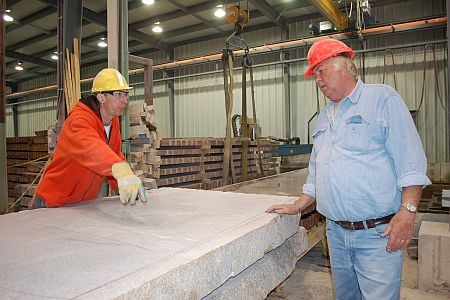Not all the high-value rock excavated from the Canadian Shield can be measured on the London Metal Exchange.
A northwestern Ontario company of quarrymen and stone cutters stretching back four generations has carved out a successful living harvesting this region's most abundant commodity.
For close to three decades, the family-run Nelson Granite of Vermilion Bay provided an inspirational story in the resource industry for their longevity and international recognition in mining and manufacturing a product that has made it a leader in the Canadian granite industry.
Porphyritic granite mined from a series of quarries near the picturesque hamlet of Vermilion Bay has made its way around the world for uses ranging from small grave markers to entire building facades for structures in Japan, China, Singapore, the United Arab Emirates, Russia and its biggest market, the U.S.
Closer to home, fine-grained Vermilion granite is in Thunder Bay's Terry Fox Memorial and in campus buildings at Lakehead University.
“It all depends on who the landscape architect is,” said the company's low-key president Carter Nelson. “If it (building design) calls for granite, we stand a good chance of getting it.”
The operation is located west of the hamlet of Vermilion Bay between Dryden and Kenora in the heart of the rugged Canadian Shield.
It's flagship Vermilion quarry of fine-grained pink and red granite sits on the north side of the Trans-Canada Highway across from its 50,000-square foot fabrication shop.
Since 1996, they've opened five more quarries within a 100-kilometre radius, each offering different colours and textures which are marketed as Canadian Mahogany, Pine Green, Canyon Red, Shepody and Crystal Gold.
Last year, the company was recognized by its peers at the Ontario Prospectors Association general meeting in Thunder Bay with a Lifetime Achievement Award.
The family's history as quarrymen goes back to 1909 in New Brunswick with Carter's grandfather George, who began as a stonecutter and passed the tradition down to Carter's father, Russell.
Today, Carter's son Nevin serves as vice-president, while his wife Carolyn works in the office.
Like many of his employees, Carter, 64, learned his skills on the job at age 15 drilling holes, cutting stone, running saws and working quarry machinery.
The move to northwestern Ontario in the early 1980s came when the company had an opportunity to buy out a competitor.
There were some initial start-up challenges, like becoming familiar with more stringent Ontario regulations of operating on Crown land compared, to the private holdings they operated on back east.
“I didn't know what I was doing as far as permitting,” said Carter, chuckling. “I just started. You used to be able to stake a claim, bring it to lease, then you could apply for a patent under the Mining Act. Now you can't do that anymore.”
Quarry operations began in 1981 before the business expanded into fabrication, sawing and polishing in the mid 1980s, making memorial monuments and granite bases for bronze plaques.
Until recently, Nelson Granite was an active exploration company on the lookout for new deposits with its own geologist equipped with ground penetrating radar.
However, frustrations over the changing and confusing Ontario permitting regime and tighter operating restrictions have put the company's plans to open new quarries on indefinite hold.
Inside their Vermilion quarry, a series of hydraulic drills carve out and square off monstrous 25 and 30 tonne blocks and slabs, which are either trucked direct from the quarry to U. S. buyers or are hauled across the highway to the company plant.
Some granite is cut-to-order while other market-desirable pieces are set aside for stock.
In the shop, the blocks are sliced by huge diamond tipped circular saws, some as large as six feet.
Beds of rollers and overhead cranes maneuver the pieces to a succession of smaller saws, cutting machines, automatic polishers and even hammer-swinging workers who chop, chisel, notch, shape and drill holes for cemetery markers, benches, cobblestones or landscaping products.
“We do everything but the engraving,” said Nelson.
The quarry runs year-round due to a well-developed U.S. market, where 75 to 80 per cent of their product goes, some of it as far south as Texas and New Mexico. About five per cent goes offshore.
As the Kenora district's only operating mine, the Ontario Geological Survey recorded Nelson Granite producing a total of 266,044 cubic feet (7,034 square metres) of stone produced from five quarries in 2008.
A division of the company is located in Elberton, Georgia – considered the granite capital of the U.S. – where the Nelson family operates a distribution warehouse for their block and slab business.
Besides building architectural work, memorial monuments are big sellers. One of their busiest times of year is during the weeks leading up to U.S. Memorial Day when the demand spikes for cemetery markers.
Surprisingly, Canadian design firms and monument dealers aren't big buyers of homegrown stone, preferring black granite instead, though Vermilion granite was used in the construction of a mausoleum in Sault Ste. Marie.
Carter, has his eye on expanding the landscaping market, especially with Queen's Park handing out cheques for communities to undertake downtown revitalization and urban design projects.
Nelson Granite cobblestone has been shipped to Kenora for that town's Main Street facelift and traffic roundabout and other products are headed for projects in Dryden and Nipigon.




